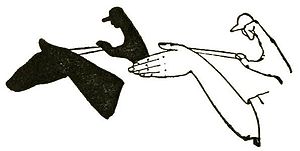Magic (Ellis Stanyon)/Chapter 11
CHAPTER XI
SHADOWGRAPHY
The idea of projecting silhouettes with the hands on a wall or illuminated screen is an old one, but it has been brought to great perfection by the celebrated French conjurer and juggler, M. Felician Trewey, and his English confrères, David Devant, Ellis Stanyon, and Hilliar. Notable among the American exhibitors of shadowgraphy is Clivette, the "Man in Black," whose clever fingers have added many new and amusing figures to the already long list. The above named artists enact little pantomimic scenes, such as a fisherman in a boat, going through the usual evolutions of a disciple of Izaak Walton; a policeman making love to a servant girl; a concierge quarreling with a belated lodger; a lover serenading his sweetheart, etc.
These shadows are best made on a screen, which is illuminated by "a single lamp inclosed in a projecting apparatus throwing very divergent rays. The lens must consequently be of very short focus. The electric light or oxyhydrogen lamp necessary in a theatre may be replaced at the amateur's house by a lamp, or better, by a wax candle." Various little accessories such as pieces of cardboard, fashioned to represent head-gear and the like, are used in the formation of many of the more elaborate figures. The use of such material is depicted in the illustrations. Makers of magical apparatus manufacture these accessories, but the clever amateur can cut them out from sheets of cardboard without going to the expense of purchasing them.
A cheap and easy way of manufacturing a silhouette of a friend is to have him pose in front of a sheet of paper hung against a wall which is illuminated by a candle. All you have to do is to outline with a pencil the shadow cast by his face, and afterward fill in the white space with black paint or crayon. The famous Levater constructed an ingenious device for making silhouettes. It is thus described in his work on physiognomy: "The shadow is projected upon a fine paper, well oiled and dried, and placed behind a piece of plate-glass supported in a frame secured to the back of the chair. Behind this glass the artist stands, and holding the frame with one hand, draws with the other." A candle furnished the necessary light.
During the French Revolution, it was a dangerous thing to possess a likeness of the martyred King Louis XVI. The scions of the nobility, resident in Paris in disguise, living, as it were, in the shadow of the guillotine, carefully hid all souvenirs of the king and royal family, until better days should dawn. To be found in possession of a portrait of the ill-fated Louis meant denunciation and death. Finally a clever wood carver of royalist persuasion succeeded in fashioning a cane which would throw a silhouette upon a wall—a likeness of Louis XVI. He drove a great trade among the aristocrats, who carried these walking sticks about with impunity, flourishing them under the very noses of the revolutionists. Nobody could possibly suspect a cane. Chessmen were also made on similar principles. When the tables were turned and Louis XVIII came to his own again, it was a dangerous thing to indulge in Napoleonic relics. A carver in wood, possibly an old soldier of the Imperial Guard, constructed a silhouette cane for the suppressed Bonapartists.
The illustrating of books and magazines with silhouette pictures has recently come into vogue. It is especially popular in Paris, where the famous caricaturist Caran d'Ache, has done much to elevate the art. After working at silhouettes for some time, he conceived the clever idea of cutting figures out in zinc and casting them upon an illuminated screen; fashioning them in sections so that they could be made to work by means of cords operated by assistants. His first exhibition was given at the Chat Noir, a cafe much frequented by artists and literary men. Finally a special representation was gotten up at the Theatre d' Application, and crowds flocked to see the silhouettes. M. d'Ache is very successful in representing military scenes. He projects upon the screen the battles and triumphal marches of the Emperor Napoleon.

PARROT

TWO FOXES FIGHTING


























